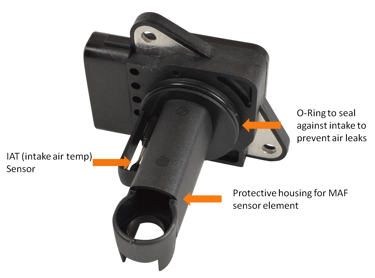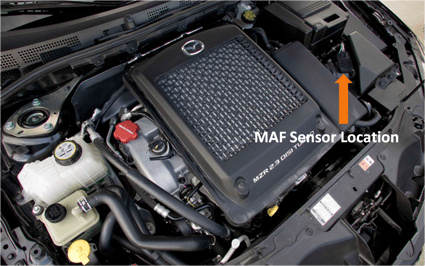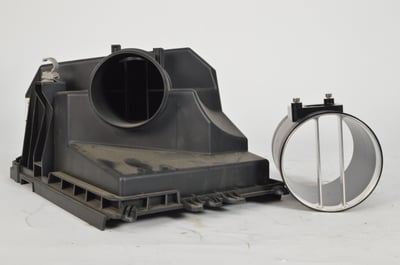Search for topics or resources
Enter your search below and hit enter or click the search icon.

Over the years, we’ve found that many people who are modifying their MAF controlled car have a misunderstanding of what needs to change or be modified in order to make more power when it comes to the intake system. Sure, a bigger intake typically yields more power through less restriction and more airflow. But increasing the size of the intake diameter isn't the only thing you have to worry about in a MAF based car and it doesn’t have anything to do with actual power production.
 Let’s start with understanding how a MAF sensor works. A MAF (mass air flow) sensor is not to be confused with a MAP (manifold absolute pressure) sensor. Although a MAF based vehicle typically uses a MAP sensor in addition, they are separate sensors altogether. The MAF sensor is used in the intake system and it is designed to measure the amount of air flowing into an engine. Once it measures how much air is coming in, it then sends that information back to the ECU so that the fuel injection system knows exactly how much fuel your engine needs to match that amount of air and perform whatever function it’s supposed to be performing at any given time in the rpm and load range.
Let’s start with understanding how a MAF sensor works. A MAF (mass air flow) sensor is not to be confused with a MAP (manifold absolute pressure) sensor. Although a MAF based vehicle typically uses a MAP sensor in addition, they are separate sensors altogether. The MAF sensor is used in the intake system and it is designed to measure the amount of air flowing into an engine. Once it measures how much air is coming in, it then sends that information back to the ECU so that the fuel injection system knows exactly how much fuel your engine needs to match that amount of air and perform whatever function it’s supposed to be performing at any given time in the rpm and load range.
 The MAF sensor is a wire located directly in the middle of the airstream somewhere in the intake pipe. In most OEM intake systems, it’s located a very short distance after the air filter. This is also referred to as a “draw through” or “pull through” MAF sensor. Some turbocharged aftermarket setups locate the sensor in the piping after the turbocharger (pressurized piping). This is referred to as a “blow through” MAF setup. There are different reasons why you can use a blow through setup but we will not discuss this here. The wire receives a certain amount of electrical current and as the air moves over it, it cools the wire and changes the electrical resistance. When this change occurs, the MAF can calculate how much air is moving over the wire based on how much the current changes. The MAF sensor voltage is tied to a mathematical equation that the ECU performs based on the diameter of the piping that the MAF sensor is sitting inside of. This is where the larger MAF housings become about more than just increasing the airflow. In a MAF based car, the OEM gave the car a certain piping diameter that would allow a certain range of airflow to be read accurately by the MAF sensor. However, if you start to make a significant amount more power, the electrical range of that sensor will become overwhelmed due to the increase in airflow. It won’t be able to read how much air is coming in after a certain point. This is usually around 5 volts. When you increase the diameter of the piping, you allow more air to flow over the 0-5 volt MAF sensor without overwhelming it with more air than it is designed to read through the change in electrical current as air passes over it.
The MAF sensor is a wire located directly in the middle of the airstream somewhere in the intake pipe. In most OEM intake systems, it’s located a very short distance after the air filter. This is also referred to as a “draw through” or “pull through” MAF sensor. Some turbocharged aftermarket setups locate the sensor in the piping after the turbocharger (pressurized piping). This is referred to as a “blow through” MAF setup. There are different reasons why you can use a blow through setup but we will not discuss this here. The wire receives a certain amount of electrical current and as the air moves over it, it cools the wire and changes the electrical resistance. When this change occurs, the MAF can calculate how much air is moving over the wire based on how much the current changes. The MAF sensor voltage is tied to a mathematical equation that the ECU performs based on the diameter of the piping that the MAF sensor is sitting inside of. This is where the larger MAF housings become about more than just increasing the airflow. In a MAF based car, the OEM gave the car a certain piping diameter that would allow a certain range of airflow to be read accurately by the MAF sensor. However, if you start to make a significant amount more power, the electrical range of that sensor will become overwhelmed due to the increase in airflow. It won’t be able to read how much air is coming in after a certain point. This is usually around 5 volts. When you increase the diameter of the piping, you allow more air to flow over the 0-5 volt MAF sensor without overwhelming it with more air than it is designed to read through the change in electrical current as air passes over it.
If you've changed the piping diameter, the MAF sensor is now sending incorrect information to the ECU. It's telling the ECU that a certain amount of air is coming in when in reality, it's a larger volume of air than what's being told to the ECU. This is an easy fix and can be done by a knowledgeable tuner or a little research on how to calibrate a MAF sensor based on your tuning software.
Another type of problem occurs when someone has already purchased an intake that was compatible with the stock MAF calibration so the car runs completely normal but you've decided to add a larger turbo or some sort of modification that stretches the limit of that MAF sensor's range by adding much more airflow. Even though you may have already purchased a higher performing intake, it is no longer able to be used due to the increase in airflow and the effect it has on the MAF. You'll need to upgrade the intake a second time with a larger diameter pipe and then, of course, recalibrate your MAF sensor along with the intake change.
 |
 |
| This MAF Housing is integrated into the factory airbox. You can see the difference in diameter from this nicer, aftermarket 3.5 inch aluminum housing. |
This uses the same Denso style MAF sensor flange |
Again, there are 2 things to consider when increasing the piping diameter in a MAF based vehicle. The first is to simply increase the airflow resulting in potential power increase. Secondly, the MAF sensor needs to be recalibrated to reflect the increased diameter of the exact area where the MAF sensor is inserted into the piping so the sensor can accurately relay information to the ECU within the range of voltage that it was designed for.
I'm the founder of Edge Autosport and I remember first getting into cars in high school. I read all the magazines, bought a bunch of technical books, and finally got to start wrenching around the age of 19. I really enjoy modding and being able to live out a passion is truly awesome. I wouldn't change a thing.